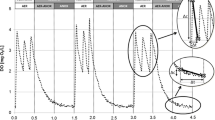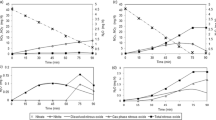Abstract
Nitrogen removal and nitrous oxide (N2O) emission in a lab-scale constant-flow multiple anoxic (A) and aerobic (O) process, combined with the addition of suspended carriers, were investigated. Under steady state, 99.9% of ammonia nitrogen (NH4-N), 76.8% of orthophosphate, and 80.2% of total inorganic nitrogen removal efficiency was achieved. The N2O emission factor during nitrification was 0.8–1.9% of the oxidized NH4-N. The emission factor increased to 7.4–45.9% with the coexistence of heterotrophic activities. Extending the anoxic time from 30 to 90 min reduced the N2O emission factor from 1.6 to 1.0%. N2O emission was stimulated with nitrite (NO2-N) as the electron acceptor, with the N2O emission factor of 5.2–5.6%. Denitrification with internal organic carbon contributed 6.8% of reduced NO2-N to N2O. NO2-N might exert a crucial role in N2O emission independent of carbon source. For the acclimated microbial communities, Nitrospira and Nitrosospira were the dominant nitrifiers and responsible for the N2O emission during nitrification. Azospira, Dechloromonas, Flavobacterium, Pseudomonas, and unclassified genus of family Comamonadaceae might be responsible for N2O emission during denitrification. These findings may guide the design of multiple AO process for controlling N2O emission.




Similar content being viewed by others
Data availability
All data generated or analyzed during this study are included in this published article.
References
APHA. (2002). Standard methods for the examination of water and wastewater. American Public Health Association.
Blackburne, R., Yuan, Z., & Keller, J. (2008). Partial nitrification to nitrite using low dissolved oxygen concentration as the main selection factor. Biodegradation, 19(2), 303–312.
Chen, H., Zeng, L., Wang, D., Zhou, Y., & Yang, X. (2020). Exploring the linkage between free nitrous acid accumulation and nitrous oxide emissions in a novel static/oxic/anoxic process. Bioresource Technology, 304, 123011.
Chen, Y., Wang, D., Zheng, X., Li, X., Feng, L., & Chen, H. (2014). Biological nutrient removal with low nitrous oxide generation by cancelling the anaerobic phase and extending the idle phase in a sequencing batch reactor. Chemosphere, 109, 56–63.
Ge, S., Peng, Y., Qiu, S., Zhu, A., & Ren, N. (2014). Complete nitrogen removal from municipal wastewater via partial nitrification by appropriately alternating anoxic/aerobic conditions in a continuous plug-flow step feed process. Water Research, 55(2), 95–105.
Guo, J., Cong, Q., Zhang, L., Meng, L., Ma, F., & Zhang, J. (2019). Exploring the linkage between bacterial community composition and nitrous oxide emission under varied DO levels through the alternation of aeration rates in a lab-scale anoxic-oxic reactor. Bioresource Technology, 291, 121809.
IPCC. (2001). Climate change 2001: the scientific basis. Cambridge University Press.
Ju, F., Guo, F., Ye, L., Xia, Y., & Zhang, T. (2014). Metagenomic analysis on seasonal microbial variations of activated sludge from a full-scale wastewater treatment plant over 4 years. Environmental Microbiology Reports, 6(1), 80–89.
Kampschreur, M. J., Temmink, H., Kleerebezem, R., Jetten, M. S. M., & van Loosdrecht, M. C. M. (2009). Nitrous oxide emission during wastewater treatment. Water Research, 43, 4093–4103.
Kornaros, M. S. N. D., Dokianakis, S. N., & Lyberatos, G. (2010). Partial nitrification/denitrification can be attributed to the slow response of nitrite oxidizing bacteria to periodic anoxic disturbances. Environmental Science & Technology, 44(19), 7245–7253.
Law, Y., Ni, B., Lant, P., & Yuan, Z. (2012). N2O production rate of an enriched ammonia-oxidising bacteria culture exponentially correlates to its ammonia oxidation rate. Water Research, 46, 3409–3419.
Liu, Y., Peng, L., Guo, J., Chen, X., Yuan, Z., & Ni, B. (2015). Evaluating the role of microbial internal storage turnover on nitrous oxide accumulation during denitrification. Scientific Reports, 5, 15138.
Otte, S., Grobben, N. G., Robertson, L. A., Jetten, M. S., & Kuenen, J. G. (1996). Nitrous oxide production by Alcaligenes faecalis under transient and dynamic aerobic and anaerobic conditions. Applied and Environmental Microbiology, 62(7), 2421–2426.
Park, H. J., Kwon, J. H., Yun, J., Cho, K. S. (2020). Characterization of nitrous oxide reduction by Azospira sp. HJ23 isolated from advanced wastewater treatment sludge. Journal of Environmental Science and Health, Part A, 1-9.
Pan, Y., Ni, B. J., Bond, P. L., Ye, L., & Yuan, Z. (2013). Electron competition among nitrogen oxides reduction during methanol-utilizing denitrification in wastewater treatment. Water Research, 47(10), 3273–3281.
Pan, M., Wen, X., Wu, G., Zhang, M., & Zhan, X. (2014). Characteristics of nitrous oxide (N2O) emission from intermittently aerated sequencing batch reactors (IASBRs) treating slaughterhouse wastewater at low temperature. Biochemical Engineering Journal, 86, 62–68.
Peng, L., Ni, B., Erler, D., Ye, L., & Yuan, Z. (2014). The effect of dissolved oxygen on N2O production by ammonia-oxidizing bacteria in an enriched nitrifying sludge. Water Research, 66, 12–21.
Peng, L., Ni, B., Ye, L., & Yuan, Z. (2015). The combined effect of dissolved oxygen and nitrite on N2O production by ammonia oxidizing bacteria in an enriched nitrifying sludge. Water Research, 73, 29–36.
Pijuan, M., Torà, J., Rodríguezcaballero, A., César, E., Carrera, J., & Pérez, J. (2014). Effect of process parameters and operational mode on nitrous oxide emissions from a nitritation reactor treating reject wastewater. Water Research, 49(1), 23–33.
Rajagopal, R., & Béline, F. (2011). Nitrogen removal via nitrite pathway and the related nitrous oxide emission during piggery wastewater treatment. Bioresource Technology, 102(5), 4042–4046.
Ren, Y., Ngo, H. H., Guo, W., Ni, B. J., & Liu, Y. (2019). Linking the nitrous oxide production and mitigation with the microbial community in wastewater treatment: a review. Bioresource Technology Reports, 7, 100191.
Smolders, G. J. F., Van der Meij, J., Van Loosdrecht, M. C. M., & Heijnen, J. J. (1994). Model of the anaerobic metabolism of the biological phosphorus removal process: stoichiometry and pH influence. Biotechnology and Bioengineering, 43(6), 461–470.
Shaw, L. J., Nicol, G. W., Smith, Z., Fear, J., Prosser, J. I., & Baggs, E. M. (2006). Nitrosospira spp. can produce nitrous oxide via a nitrifier denitrification pathway. Environmental Microbiology, 8(2), 214–222.
Sun, Y., Guan, Y., Pan, M., Zhan, X., Hu, Z., & Wu, G. (2017). Enhanced biological nitrogen removal and N2O emission characteristics of the intermittent aeration activated sludge process. Reviews in Environmental Science and Bio/Technology, 16(12), 1–20.
Sun, Y., Wang, H., Wu, G., & Guan, Y. (2018a). Nitrogen removal and nitrous oxide emission from a step-feeding multiple anoxic and aerobic process. Environmental Technology, 39(7), 814–823.
Sun, Y., Guan, Y., Wang, D., Liang, K., & Wu, G. (2018b). Potential roles of acyl homoserine lactone based quorum sensing in sequencing batch nitrifying biofilm reactors with or without the addition of organic carbon. Bioresource Technology, 259, 136–145.
Sun, Y., Xin, L., Wu, G., & Guan, Y. (2019). Nitrogen removal, nitrous oxide emission and microbial community in sequencing batch and continuous-flow intermittent aeration processes. Environmental Engineering Research, 24(1), 107–116.
Tallec, G., Garnier, J., Billen, G., & Gousailles, M. (2006). Nitrous oxide emissions from secondary activated sludge in nitrifying conditions of urban wastewater treatment plants: Effect of oxygenation level. Water Research, 40(15), 2972–2980.
Tang, B., Wu, G., Wang, H., & Guan, Y. (2016). Nitrous oxide emission depending on the type of electron acceptor by a denitrifying phosphorus removal sludge. Global NEST Journal, 18(2), 251–258.
Tumendelger, A., Alshboul, Z., & Lorke, A. (2019). Methane and nitrous oxide emission from different treatment units of municipal wastewater treatment plants in Southwest Germany. PLoS One, 14(1), e0209763.
Valverde-Pérez, B., Mauricio-Iglesias, M., & Sin, G. (2016). Systematic design of an optimal control system for the sharon-anammox process. Journal of Process Control, 39, 1–10.
Waki, M., Yasuda, T., Fukumoto, Y., Béline, F., & Magrí, A. (2020). Numerical assessment of nitrogen removal from swine wastewater in activated sludge systems: comparison between continuous and intermittent aeration. Bioresource Technology Reports, 11, 100492.
Weisener, C., Lee, J., Chaganti, S. R., Reid, T., Falk, N., & Drouillard, K. (2017). Investigating sources and sinks of N2O expression from freshwater microbial communities in urban watershed sediments. Chemosphere, 188, 697–705.
Wunderlin, P., Mohn, J., Joss, A., Emmenegger, L., & Siegrist, H. (2012). Mechanisms of N2O production in biological wastewater treatment under nitrifying and denitrifying conditions. Water Research, 46(4), 1027–1037.
Wang, H., Guan, Y., Pan, M., & Wu, G. (2016). Aerobic N2O emission for activated sludge acclimated under different aeration rates in the multiple anoxic and aerobic process. Journal of Environmental Sciences, 43, 70–79.
Wang, H., Sun, Y., Li, L., & Wu, G. (2018). Enhanced nitrogen removal and minimization of N2O emission in a constant-flow multiple anoxic and aerobic process. Journal of Water Process Engineering, 26, 336–341.
Wang, H., Sun, Y., Wu, G., & Guan, Y. (2019). Effect of anoxic to aerobic duration ratios on nitrogen removal and nitrous oxide emission in the multiple anoxic/aerobic process. Environmental Technology, 40(13), 1676–1685.
Xing, L., Ou, L., Zhang, Y., Zheng, D., & Wu, G. (2017). Nitrogen removal and N2O emission during low carbon wastewater treatment using the multiple A/O process. Water, Air, and Soil Pollution, 228(9), 367.
Yu, R., Kampschreur, M. J., Loosdrecht, M. C. V., & Chandran, K. (2010). Mechanisms and specific directionality of autotrophic nitrous oxide and nitric oxide generation during transient anoxia. Environmental Science & Technology, 44(4), 1313–1319.
Zhang, M., Lawlor, P. G., Li, J., & Zhan, X. (2012). Characteristics of nitrous oxide (N 2 O) emissions from intermittently-aerated sequencing batch reactors treating the separated liquid fraction of anaerobically digested pig manure. Water, Air, and Soil Pollution, 223(5), 1973–1981.
Zeng, R. J., Lemaire, R., Yuan, Z., & Keller, J. (2003). Simultaneous nitrification, denitrification, and phosphorus removal in a lab-scale sequencing batch reactor. Biotechnology and Bioengineering, 84(2), 170–178.
Author information
Authors and Affiliations
Contributions
Huqing Wang and Li Li carried out the experiments. Li Li analyzed the data. Huoqing Wang wrote the manuscript. Yuepeng Sun conceived the study and were in charge of overall direction and planning. All authors discussed the results and contributed to the final manuscript.
Corresponding author
Ethics declarations
Conflict of Interest
The authors declare no conflict of interest.
Additional information
Publisher’s Note
Springer Nature remains neutral with regard to jurisdictional claims in published maps and institutional affiliations.
Rights and permissions
About this article
Cite this article
Wang, H., Li, L. & Sun, Y. Nitrogen Removal and Nitrous Oxide Emission in a Constant-Flow Multiple Anoxic and Aerobic Process. Water Air Soil Pollut 232, 285 (2021). https://doi.org/10.1007/s11270-021-05244-7
Received:
Accepted:
Published:
DOI: https://doi.org/10.1007/s11270-021-05244-7




